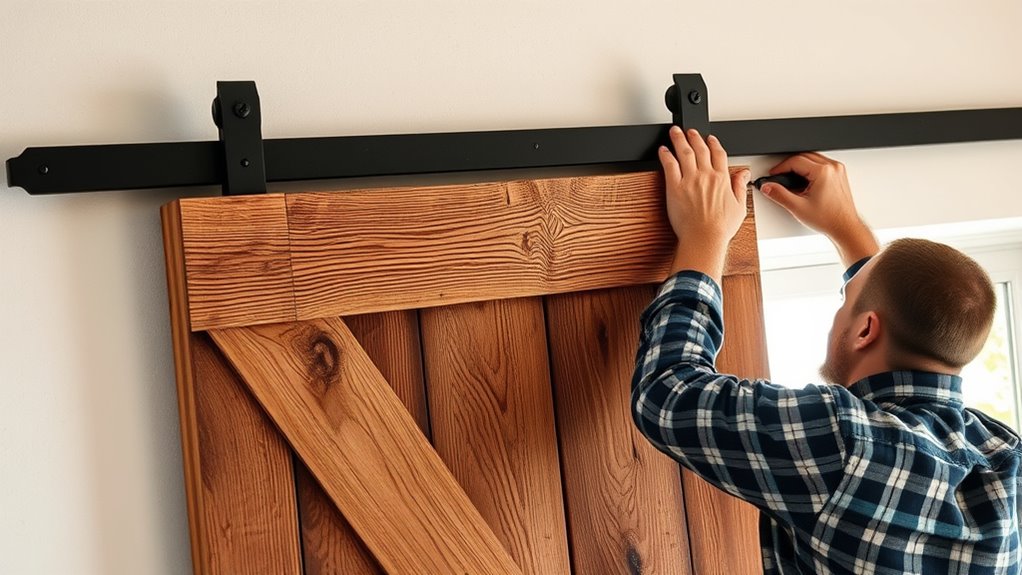To build a sliding barn door, start by measuring your doorway accurately, considering door size and space needed when open. Choose the hardware style and finish that match your decor and guarantee it supports the weight of your door. Install the track securely on wall studs or ceiling joists, following the manufacturer’s instructions, and hang your door with rollers or hangers. Proper setup ensures smooth operation and long-lasting function—stick with us to learn more about each step.
Key Takeaways
- Measure doorway dimensions accurately to select the appropriate track length and door size.
- Choose hardware style and finish that match your aesthetic, ensuring it supports the door weight.
- Install the track securely into studs or ceiling joists using proper anchors and level for even installation.
- Attach rollers or hangers to the door before mounting onto the track, ensuring smooth sliding operation.
- Regularly inspect, lubricate, and reinforce hardware to maintain safety, durability, and long-term performance.

Building a sliding barn door is a rewarding project that can enhance your home’s style and functionality. When it comes to choosing the right hardware options, you have a variety of styles and finishes to think about. From rustic iron tracks to sleek modern aluminum systems, your selection will influence both the look and the durability of your door. Think about the overall aesthetic you want to achieve—whether it’s farmhouse charm or contemporary minimalism—and pick hardware that complements that style. Solid steel or heavy-duty track systems provide stability and support for larger doors, while lighter options work well for smaller, less frequently used doors. Remember, the hardware isn’t just about appearance; it needs to be robust enough to handle the weight of your door over time.
Choose durable hardware that complements your style for a beautiful, long-lasting sliding barn door.
As you plan your installation, keep in mind some essential tips to guarantee a smooth process. First, measure carefully. Measure the width and height of your doorway, and decide how much space you want the door to cover when open. Make sure to account for the thickness of your door and the hardware, so it will slide fully open without obstruction. Once you’ve got your measurements, locate the wall studs or ceiling joists where the track will be mounted. Using a level, mark the exact placement for the track to ensure your door hangs evenly. Proper alignment is vital for smooth operation and safety.
Next, follow the manufacturer’s instructions for installing the hardware. Typically, this involves attaching the track securely to the wall or ceiling using appropriate anchors or screws. Use a drill and level to keep everything straight. If your hardware includes rollers or hangers, install these onto the top of your door first, then hang your door on the track carefully. Double-check that the door slides smoothly and doesn’t wobble. For heavier doors, consider adding additional support brackets or using more robust hardware options to prevent sagging over time.
Finally, pay attention to safety. Make sure the hardware is rated for the weight of your door, and regularly check the mounting points for any signs of wear or looseness. Lubricate moving parts periodically to keep the sliding smooth and quiet. With proper hardware choices and installation tips, your DIY sliding barn door will not only look fantastic but also function reliably for years to come. Taking your time during the planning and installation process guarantees a professional finish and a beautiful, functional addition to your home. Additionally, selecting hardware with high load capacity ensures your door remains secure and operational over time.
Frequently Asked Questions
What Are the Best Types of Wood for Sliding Barn Doors?
When choosing the best wood types, you should consider the wood grain and stain options. Hardwoods like oak, walnut, and maple offer durability and attractive grain patterns, making them ideal for sliding barn doors. Softwoods like pine are budget-friendly and accept stains well, allowing you to customize the look. Your choice depends on your aesthetic preference and functional needs, ensuring the door complements your space beautifully.
How Much Space Is Needed for Proper Door Clearance?
You need to take into account door clearance and space requirements carefully. To ensure smooth operation, leave about 1-2 inches of clearance on each side of the door. Additionally, account for the track and hardware when planning your space. Typically, you’ll want at least 12-14 inches of space in front of the door to allow it to slide open fully without obstruction. Proper planning helps your door move smoothly and prevents damage.
Can Sliding Barn Doors Be Insulated for Soundproofing?
Imagine your space wrapped in a quiet, cozy blanket—soundproofing options can make that happen. You can insulate sliding barn doors with insulation materials like foam panels, mineral wool, or acoustic mats, which absorb sound waves and keep noise out. These materials fit snugly within the door, transforming your entryway into a sanctuary of silence. With the right soundproofing options, you create a peaceful retreat from the outside world.
What Hardware Options Are Most Durable for Outdoor Use?
When selecting hardware for outdoor use, you want options that withstand the elements. Metal hinges with weather-resistant finishes are your best choice, as they resist rust and corrosion over time. Look for hardware made from stainless steel or galvanized steel, which provide durability and longevity. These materials ensure your sliding barn door stays functional and secure, even in harsh weather conditions, giving you peace of mind and lasting performance.
How Do I Maintain and Clean My Sliding Barn Door?
Think of your sliding barn door as a well-tuned instrument. To keep it singing smoothly, regularly check hinge lubrication to prevent squeaks and rust. Use gentle cleaning techniques with a soft cloth to remove dust and dirt, avoiding harsh chemicals. Keep the track clean and free of debris, and periodically inspect for wear. With consistent care, your door will glide effortlessly and stay beautiful for years to come.
Conclusion
Now, step back and admire your masterpiece—a stunning barn door so majestic, it could block out the sun itself! With your hands, you’ve created a gateway that’s as strong as a fortress and as smooth as glass. Every time you slide it open, you’ll feel like a craftsman who’s tamed the wildest woods and turned them into pure magic. This door isn’t just functional; it’s a breathtaking centerpiece that’ll leave everyone in awe!









